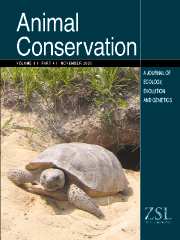Crossref Citations
This article has been cited by the following publications. This list is generated based on data provided by
Crossref.
Leslie, David M.
Groves, Colin P.
and
Abramov, Alexei V.
2010.
Procapra przewalskii (Artiodactyla: Bovidae).
Mammalian Species,
Vol. 42,
Issue. ,
p.
124.
Zachos, Frank E.
Karami, Mahmoud
Ibenouazi, Zahra
Hartl, Günther B.
Eckert, Iris
and
Kirschning, Julia
2010.
First genetic analysis of a free-living population of the threatened goitered gazelle (Gazella subgutturosa).
Mammalian Biology,
Vol. 75,
Issue. 3,
p.
277.
Hu, Junhua
Ping, Xiaoge
Cai, Jing
Li, Zhongqiu
Li, Chunwang
and
Jiang, Zhigang
2010.
Do local communities support the conservation of endangered Przewalski’s gazelle?.
European Journal of Wildlife Research,
Vol. 56,
Issue. 4,
p.
551.
Yang, Ji
Jiang, Zhigang
Zeng, Yan
Turghan, Mardan
Fang, Hongxia
Li, Chunwang
and
Gilbert, M. Thomas P.
2011.
Effect of Anthropogenic Landscape Features on Population Genetic Differentiation of Przewalski's Gazelle: Main Role of Human Settlement.
PLoS ONE,
Vol. 6,
Issue. 5,
p.
e20144.
Chan, Chi-Hang
Robertson, Hugh A.
Saul, Edward K.
Nia, Lynda V.
Luong, Vy Phuong
Kong, Xiaochen
Zhao, Yudi
and
Chambers, Geoffrey K.
2011.
Genetic variation in the kakerori (Pomarea dimidiata), an endangered endemic bird successfully recovering in the Cook Islands.
Conservation Genetics,
Vol. 12,
Issue. 2,
p.
441.
Yang, Ji
and
Jiang, Zhigang
2011.
Genetic diversity, population genetic structure and demographic history of Przewalski’s gazelle (Procapra przewalskii): implications for conservation.
Conservation Genetics,
Vol. 12,
Issue. 6,
p.
1457.
Valtonen, Mia
Palo, Jukka U.
Ruokonen, Minna
Kunnasranta, Mervi
and
Nyman, Tommi
2012.
Spatial and temporal variation in genetic diversity of an endangered freshwater seal.
Conservation Genetics,
Vol. 13,
Issue. 5,
p.
1231.
Li, Chunlin
Jiang, Zhigang
Ping, Xiaoge
Cai, Jing
You, Zhangqiang
Li, Chunwang
and
Wu, Yonglin
2012.
Current status and conservation of the Endangered Przewalski's gazelleProcapra przewalskii, endemic to the Qinghai–Tibetan Plateau, China.
Oryx,
Vol. 46,
Issue. 1,
p.
145.
You, ZhangQiang
Jiang, ZhiGang
Li, ChunWang
and
Mallon, David
2013.
Impacts of grassland fence on the behavior and habitat area of the critically endangered Przewalski’s gazelle around the Qinghai Lake.
Chinese Science Bulletin,
Vol. 58,
Issue. 18,
p.
2262.
Mardan, Turghan
Jiang, ZhiGang
Groves, Colin P.
Yang, Ji
and
Fang, HongXia
2013.
Subspecies in Przewalski’s gazelle Procapra przewalskii and its conservation implication.
Chinese Science Bulletin,
Vol. 58,
Issue. 16,
p.
1897.
Li, Chunlin
Jiang, Zhigang
Fang, Hongxia
Li, Chunwang
and
Hewitt, Judi
2013.
A Spatially Explicit Model of Functional Connectivity for the Endangered Przewalski’s Gazelle (Procapra przewalskii) in a Patchy Landscape.
PLoS ONE,
Vol. 8,
Issue. 11,
p.
e80065.
Okada, Ayumi
Ito, Takehiko Y.
Buuveibaatar, Bayarbaatar
Lhagvasuren, Badamjav
and
Tsunekawa, Atsushi
2015.
Genetic structure in Mongolian gazelles based on mitochondrial and microsatellite markers.
Mammalian Biology,
Vol. 80,
Issue. 4,
p.
303.
Yu, He
Song, Shiya
Liu, Jiazi
Li, Sheng
Zhang, Lu
Wang, Dajun
and
Luo, Shu-Jin
2017.
Effects of the Qinghai-Tibet Railway on the Landscape Genetics of the Endangered Przewalski’s Gazelle (Procapra przewalskii).
Scientific Reports,
Vol. 7,
Issue. 1,
Khosravi, Rasoul
Malekian, Mansoureh
Hemami, Mahmoud-Reza
Silva, Teresa Luísa
and
Brito, José Carlos
2019.
Low genetic diversity in the vulnerable Goitred Gazelle,Gazella subgutturosa(Cetartiodactyla: Bovidae), in Iran: potential genetic consequence of recent population declines.
Zoology in the Middle East,
Vol. 65,
Issue. 2,
p.
104.
Zhang, Jingjie
Jiang, Feng
Cai, Zhenyuan
Dai, Yunchuan
Liu, Daoxin
Song, Pengfei
Hou, Yuansheng
Gao, Hongmei
and
Zhang, Tongzuo
2021.
Resistance-Based Connectivity Model to Construct Corridors of the Przewalski’s Gazelle (Procapra Przewalskii) in Fragmented Landscape.
Sustainability,
Vol. 13,
Issue. 4,
p.
1656.
Wu, Ting
He, Jian
and
Shen, Xiaoyun
2022.
Study of metabolomics in selenium deprived Przewalski’s Gazelle (Procapra przewalskii).
British Journal of Nutrition,
Vol. 128,
Issue. 3,
p.
549.
Rey-Iglesia, Alba
Hjort, Jeanne
Silva, Teresa L
Buuveibaatar, Bayarbaatar
Dalannast, Munkhnast
Ulziisaikhan, Tumendemberel
Chimeddorj, Buyanaa
Espregueira-Themudo, Gonçalo
and
Campos, Paula F
2022.
Genetic diversity of the endangered Mongolian saiga antelopeSaiga tatarica mongolica (Artiodactyla: Bovidae) provides insights into conservation.
Biological Journal of the Linnean Society,
Vol. 137,
Issue. 1,
p.
100.
Shi, Lupeng
Yang, Xiufeng
Cha, Muha
Lyu, Tianshu
Wang, Lidong
Zhou, Shengyang
Dong, Yuehuan
Dou, Huashan
and
Zhang, Honghai
2023.
Genetic diversity and structure of mongolian gazelle (Procapra gutturosa) populations in fragmented habitats.
BMC Genomics,
Vol. 24,
Issue. 1,
Song, Pengfei
Jiang, Feng
Liu, Daoxin
Cai, Zhenyuan
Gao, Hongmei
Gu, Haifeng
Zhang, Jingjie
Li, Bin
Xu, Bo
and
Zhang, Tongzuo
2024.
Gut microbiota non-convergence and adaptations in sympatric Tibetan and Przewalski’s gazelles.
iScience,
Vol. 27,
Issue. 3,
p.
109117.
Guo, Yanqing
Garber, Paul A.
Ping, Renbao
and
Zhou, Jiang
2024.
Population Viability and Genetic Structure of the Last Remaining Population of the Critically Endangered Gray Snub-Nosed Monkey (Rhinopithecus brelichi).
International Journal of Primatology,
Vol. 45,
Issue. 5,
p.
1286.


